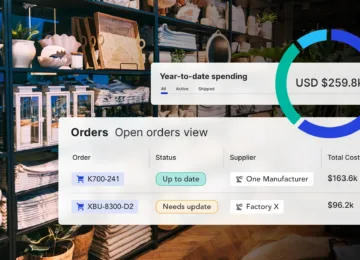As the world of retail becomes increasingly competitive, direct-to-consumer (DTC) brands and legacy retailers are looking beyond top line revenue growth to increase their bottom-line profitability.
Perhaps more than any other part of the business, inventory holds the key to greater profitability in e-commerce. However, as more brands expand into new channels, planning your inventory becomes more complex. To achieve greater operational efficiency and ROI, you need to understand your complete e-commerce inventory position across all channels in real-time.
With a modern approach to inventory planning, you can prevent stockouts, minimize excess inventory, and use your warehouse space more efficiently. All of which can lead to increased sales and profitability.
Though it isn’t simple, better inventory planning is doable. Here are the top challenges threatening your e-commerce inventory, plus practical ways to boost your profitability through inventory optimization.
Challenge #1. Excess inventory and trapped capital
Last year was known to many as the “year of the inventory glut,” with big-box retailers losing billions in operating income due to excess inventory.
When you look at recent e-commerce history, it makes sense.
After years of lost sales due to stockouts, many brands overcorrected for the rise in pandemic-era shopping. Today, it’s common to see online retailers carrying more than 90 days of average inventory, despite the fact that this often requires three times more capital than necessary.
Today, 66% of businesses report being overstocked. With working capital held up in excess inventory, you have less available capital to invest into the business. Instead of moving quickly to take advantage of time-sensitive supplier discounts or advertising opportunities, you’re focused on offloading your overstock and freeing up working capital, while your competitors continue scaling.
The solution: Increased inventory visibility
To optimize inventory levels and improve your capital position, you need an inventory system that gives you full visibility into past, present, and future inventory levels.
Look for a platform that unifies data from all your sales channels and offers real-time visibility into every node of your supply chain, including your units in:
- Warehouses or 3PLs
- Fulfillment centers (e.g., Amazon’s FBA, Shopify’s SFN)
- Open purchase orders (POs)
- Transit (e.g., on the ocean or in air)
- Production
By accounting for the full picture of your inventory levels, you can minimize the likelihood of ordering more inventory than you need and free up more capital to invest in ROI-generating activities. If you find an excess of inventory in any of your sales channels or storage locations, you can easily reroute your inventory and adjust sales in real-time.
2. Increased storage fees eat into profit margins
From Amazon to Shopify, many marketplaces and e-commerce platforms are making big changes to their fulfillment models to account for rising storage and warehousing costs.
If you’re over-ordering safety stock to compensate for poor inventory replenishment systems, you’re paying for warehousing space you don’t need to hold onto inventory you’re not going to sell.
With storage fees eating away at your margins, it becomes increasingly difficult to execute a high-ROI growth strategy. Combine these fee increases with trapped capital in excess inventory, and profitable scaling can start to feel impossible.
This is largely due to a simple lack of streamlined data leading to siloed and inefficient operations. While you may have been able to get away with inventory tracking via emailed orders and Excel spreadsheets in the early days of the business, the fulfillment juggling act becomes much harder to manage as the number of sales channels and inventory locations grows.
The solution: Streamlined inventory tracking
To reduce the likelihood of using storage space you don’t actually need, use an inventory planning system that makes it easy to segment your inventory by sales channel.
For example, if you have both wholesale and retail inventory, start by flagging a portion of your inventory to be sold for wholesale, so the rest can be forecasted without over-forecasting — which could lead to increased storage fees or stockouts due to not previously allocating the wholesale inventory.
With a 360⁰ view of sales, inventory, and supply chain data, you can master your order fulfillment for multiple locations, without overpaying in storage fees.
3. Stockouts results in lost sales and revenue
On the opposite end of the inventory management spectrum are your stockouts, which can lead to a major loss in sales and revenue.
Unfortunately, the consequences don’t stop there. Marketplace algorithms are trained to “punish” brands that go out of stock, which can quickly lead to lost rankings that are notoriously difficult to recover.
Manually analyzing your sales and inventory metrics can take days, which means longer time between orders and increased risk of stockouts due to gut instinct and “best-guesses”.
The solution: Feed your forecasts with clean data
If you feed your demand forecasts with faulty data, they’ll deliver faulty forecasts.
Many retailers rely on forecasts that are based on a moving average, where the average amount sold over a specific time period, for example the last 30, 60, or 90 days, dictates your forecast. However, this can lead to costly mistakes in your inventory planning.
If your forecast is based on sales data that includes low-in-stock inventory or past stockouts, it’s easy to view that as a seasonal pattern rather than an outlier and fail to order enough replenishments, leading to even more stockouts in the future.
Data pre-processing can help you reduce stockouts by adjusting your sales and inventory data for anomalies to improve your forecast accuracy.
4. Siloed teams and poor decision making
73% of businesses say they’re planning to scale into a new channel in the next 6-12 months, but is your team really ready? Do they know how many units are sitting in your warehouses or 3PLs? How many are sitting in your fulfillment centers?
Your decisions are only as good as your data, yet 67% of supply chain managers report using Excel to manage their inventory, leading to expensive mistakes and missed revenue opportunities.
The solution: A single source of truth for inventory planning
Empower your team to make better decisions using the same data, updated in real-time. Look for an inventory platform that acts as a single source of truth for your sales and inventory data.
With the right system, you’ll be able to:
- Gain full visibility into your inventory and supply chain positions
- Arm your team to make data-driven replenishment choices
- Free up more time for collaboration and innovation
The simple act of providing access to a strong forecast and clear insights across the value chain, you’ll be able to pinpoint profitable opportunities for new products, markets, and supplier agreements, leading to increased profits and cash flow as you scale.
5. Misalignment between sales and inventory
Many inventory management solutions treat sales and inventory as two separate tasks, leading to costly discrepancies and missed sales opportunities.
Without consideration for important factors like seasonality and inventory restrictions, you can easily end up back in the trap of lost sales, excess inventory, or overspending on marketing and advertising, damaging both your sales and margins.
The solution: A customizable inventory platform
As you expand your brand into profitable new areas, you need an inventory planning process that can help preserve your margins.
With a customizable inventory platform, you can forecast mid- to long-term demand using machine learning to deliver customizations for:
- Predicted growth
- Testing scenarios
- Comparisons
- Planned marketing events
- Outliers and other variables
Now that AI is a reality in the world of inventory planning, inventory planners finally have the tools they need to cement their position as leaders within the business.
With the power of machine learning, you can go beyond manual processes and Excel spreadsheets to making profitable data-driven decisions in real-time.
Inventory is the new frontier for successful brands
Inventory is a long game, but in the future of e-commerce, it’s critical to staying ahead.
Modern inventory planning technology is here to save you time, improve ROI, and ensure a healthy future for your brand.
Flieber’s inventory optimization solution offers advanced demand planning, real-time adjustments, and timely replenishment recommendations that scale as you do.
With Flieber, you can reduce stockouts and overstocks, increase sales, and save money on storage costs. Say goodbye to missed opportunities and trapped capital. Experience the power of Flieber. To learn more, visit https://www.flieber.com/.



